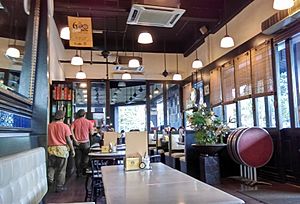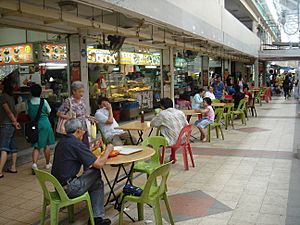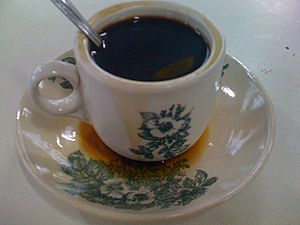Kopi tiam facts for kids

A kopitiam or kopi tiam is a special kind of coffee shop. You can find them mostly in countries like Indonesia, Malaysia, Singapore, Brunei, and Southern Thailand. People go to kopitiams for tasty meals and refreshing drinks. These shops were traditionally run by Chinese communities in these areas.
The word kopi means coffee in Indonesian and Malay. The word tiam comes from the Hokkien and Hakka languages, and it means shop. So, a kopitiam is literally a "coffee shop"!
At a kopitiam, you'll usually find simple but delicious food. This often includes dishes made with eggs and toast. They also serve kaya, which is a sweet jam made from coconut. For drinks, you can get coffee, tea, Horlicks, and Milo.
Contents
Kopitiams in Malaysia

Just like in Singapore, kopitiams are very common in Malaysia. However, there are a few small differences in how they are seen there:
- In Malaysia, the term kopitiam usually refers specifically to coffee shops run by Malaysian Chinese people.
- The food you find in a kopitiam is almost always Malaysian Chinese cuisine.
- Large food courts or hawker centres are usually not called kopitiams.
Recently, a new type of "modern" kopitiam has become popular. These new places look like the old-fashioned kopitiams inside. They have a similar style and feel, bringing back a sense of the past. But they are usually built in cleaner, more modern places, like shopping malls. This is different from the traditional shops found in old buildings. These new kopitiams are very popular with young people.
To give you the real kopitiam experience, modern kopitiams often serve authentic local coffee. They also offer charcoal-grilled toast with butter and kaya. You can also get soft-boiled eggs. Some modern kopitiams have bigger menus. They serve local breakfast, lunch, and dinner meals. Many of these newer kopitiams also serve halal food. This means the food is prepared in a way that is allowed for Muslim people to eat. This is different from some traditional kopitiams.
Today, there are more than 100 different brands of modern kopitiams across Malaysia. In the Ipoh old town area, kopitiams are famous for their Ipoh white coffee. This coffee is special because the beans are roasted with palm-oil margarine and less sugar. This makes the coffee lighter in color than regular coffee.
Kopitiams in Singapore
Kopi tiams, or coffee shops, are very common in Singapore. You can find them in almost every neighborhood, as well as in business areas. There are about 2,000 kopitiams in Singapore! Most of them are a collection of small food stalls. Each stall has a similar look and style of sign.
In a typical kopitiam, the owner usually runs the drinks stall. They sell coffee, tea, soft drinks, and other beverages. They also offer breakfast items like kaya toast and soft-boiled eggs. Other stalls are rented out to different cooks. These cooks prepare a wide variety of food dishes, often featuring Singaporean food. You can usually find traditional dishes from different cultures at kopitiams. This helps people from different backgrounds enjoy meals together.
Coffee became popular in Singapore as the country grew. It helped meet the needs of the European people living there, who loved coffee. Kopitiam is also the name of a large food court chain in Singapore. Some well-known kopitiams in Singapore include Kim San Leng, Killiney, Tong Ah Eating House, and Ya Kun Kaya Toast.
Besides eggs and toast, you can find many other common foods at kopitiams. These include char kway tiao, which are fried flat rice noodles. You might also see Hokkien mee, which are yellow wheat noodles with seafood and egg. Perhaps the most common dish is nasi lemak. This is a Malay dish of coconut-flavored rice served with spicy sambal chili paste, egg, and fried anchovies.
What is "Coffee shop talk"?
The phrase "coffee shop talk" is used to describe gossip or casual chatting. This is because it's a common sight at kopitiams. You often see groups of friends or older people sitting around. They drink coffee and share news and opinions on many topics. This can include national news, office stories, TV shows, sports, and food.
How to order drinks at a Kopitiam
At kopitiams, people often order coffee and tea using special words. These words come from different languages. You can add these words to your order to get your drink exactly how you like it:
- Kopi: This is the Malay word for coffee.
- Teh: This is the Malay or Hokkien word for tea.
- O: This means "no milk." It comes from Hokkien.
- Si or C: This means "with evaporated milk." It comes from the Hainanese dialect.
- Siew dai: This means "less sugar or milk." It comes from Hockchew or Fuzhou dialect.
- Ga dai: This means "more sugar or milk."
- Kosong: This means "no sugar." It's a Malay word for "zero."
- Kao: This means "extra thick." It comes from Hokkien.
- Poh: This means "extra thin." It comes from Hokkien.
- Di loh: This means "straight, no water added."
- Peng: This means "with ice." It comes from Hokkien.
- Pua sio: This means "half hot" in Hokkien. It gives you a warm, drinkable coffee or tea.
- Tarik: This is a Malay word meaning "pulled." It refers to how teh tarik is made.
You can combine these words to customize your drink. For example, "kopi si kosong" means coffee with evaporated milk and no sugar. The order usually goes: drink – milk – sugar – how strong it is – temperature.
Examples of Kopitiam Drinks
- Kopi o: Hot black coffee with sugar.
- Kopi o peng: Iced black coffee with sugar.
- Kopi o kosong: Hot black coffee without sugar.
- Kopi o kosong peng: Iced black coffee without sugar.
- Kopi: Coffee with condensed milk.
- Kopi peng: Iced coffee with condensed milk.
- Kopi si: Hot coffee with evaporated milk and sugar.
- Kopi si kosong: Hot coffee with evaporated milk, no sugar.
- Kopi si peng: Iced coffee with evaporated milk and sugar.
- Kopi sterng: Iced coffee that is extra smooth.
- Teh o: Hot tea without milk, with sugar.
- Teh o peng: Iced tea without milk, with sugar.
- Teh o kosong: Hot tea without milk, no sugar.
- Teh o kosong peng: Iced tea without milk, no sugar.
- Teh: Tea with condensed milk.
- Teh tarik: Tea with condensed milk that is "pulled" (poured from a height) many times.
- Teh peng: Iced milk tea with sugar.
- Teh si: Hot tea with evaporated milk and sugar.
- Teh si kosong: Hot tea with evaporated milk, no sugar.
- Teh si peng: Iced tea with evaporated milk and sugar.
- Tiao hee or tiao her: Chinese tea.
- Tat kiu: Milo.
- Cham: A mix of coffee and tea, with sugar.
- Cham peng: The iced version of Cham, with sugar.
- Yin yang or Yuan yang: Same as Cham.
- Michael Jackson: A mix of soy milk and grass jelly (black and white, like Michael Jackson's song "Black or White").
- Tai Ka Ho: Horlicks (this means 'Hello everyone').
See also
In Spanish: Kopitiam para niños



